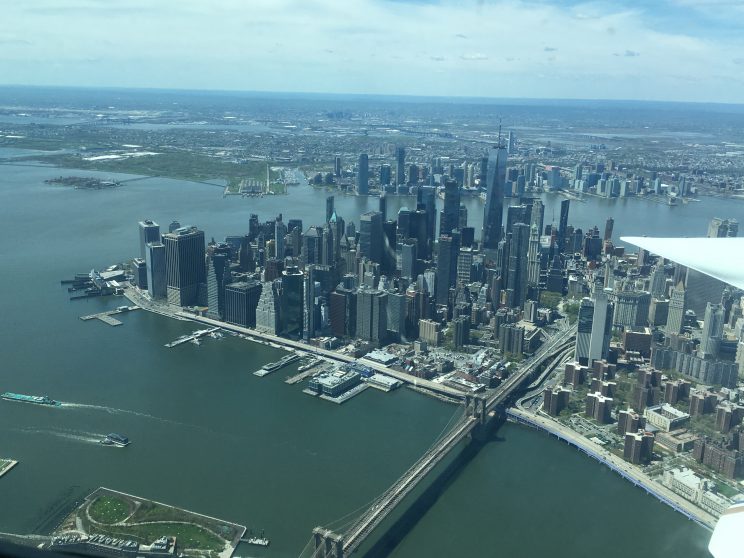Investigating COVID-19’s impacts on air quality
May 2020
May 2020

Southern Manhattan, Brooklyn Bridge taken during a flight over the East River on April 28, 2020. Credit: NOAA
ARL is a relatively small organization with a dedicated, driven staff of scientists whose work, until recently, was primarily known within the atmospheric science community. Historic changes to the rhythms of everyday life brought on by the world’s response to the coronavirus pandemic have yielded similarly unprecedented research opportunities that have thrust ARL’s work into the national media spotlight. Suddenly there’s a collective keen interest in air quality as people begin to read about and more fully understand the connections between human activity and the environment.
The lull in economic activity is enabling ARL’s scientists to conduct research activities that will forever change our scientific understanding of air quality, gathering and analyzing data that will ultimately be used to improve operational forecast models which, in turn, will further improve our nation’s ability to respond to air quality issues.
Our personnel collaborate with their counterparts in NOAA’s National Weather Service and the U.S. Environmental Protection Agency, and are ultimately responsible for updating and ensuring the optimal performance of our country’s operational air quality forecast capability. Their analyses lead to annual updates of sulfur dioxide (SO2) and nitrogen oxide (NOx) emissions; the “ingredients” that cause chemical reactions to produce ozone (O3) and fine particulate matter (PM2.5). Ozone and PM2.5 are the two most critical pollutants in defining air quality that impacts human health. PM2.5 emissions are associated with multiple economic sectors, so their decline was more immediately noticeable and reported upon. Dr. Patrick Campbell was quoted in a Politico subscriber’s article in early April, citing a noticeable nationwide decline in PM2.5 emissions from the same period (January 5 – April 5) in 2019.
ARL has several distinct research activities related to COVID-19’s impact on air quality:
ARL is collaborating with the University of Maryland (UMD), NOAA’s Global Monitoring Laboratory, Purdue University and Stony Brook University in the East Coast Outflow – COVID field study, known as ECO-COVID. The study was designed to characterize the emissions of air pollutants and greenhouse gases and to assess the impact of the COVID-19 pandemic on urban emissions. Results will be used to evaluate emission inventories (detailed estimates of the amount and type of pollutants discharged into the atmosphere) and coupled with an inverse model to better estimate urban emissions of greenhouse gas and air pollutants.
Three small, instrumented aircraft made multiple flights over Washington, Baltimore, Philadelphia, New York, Providence and Boston to measure levels of carbon dioxide, methane, carbon monoxide and other air pollutants upwind and downwind of urban areas. ARL’s Dr. Xinrong Ren participated in two research flights over the Washington, D.C. and Baltimore metropolitan region in April 2020. Preliminary results showed smaller enhancements of air pollutants and greenhouse gases in the urban plumes compared to pre-COVID-19 flights, indicating the large impacts of travel restrictions. He participated in multiple flights through mid-May, and will resume flights when the summer ozone season begins. Dr. Ren gave multiple interviews recently and was featured in articles by New York Times and Gizmodo.
In April, a team of scientists from ARL, UMD and the Maryland Department of the Environment deployed instruments at two field sites in the Washington-Baltimore region to monitor air quality and greenhouse gases during the COVID-19 outbreak. Scientists are monitoring the automated instruments remotely, collecting levels of carbon and sulfur dioxides, methane and ozone and transferring the data via the internet.
The instruments are located near Interstate Highway 95 in Laurel, Maryland and on the roof of a UMD building in College Park, MD. The observed pollutant concentrations will be used to improve emissions in future model simulations.
ARL scientists are utilizing surface pollutant observations to investigate changes in human activity and assess the speed of ongoing economic recovery in various sectors of the Chinese economy. Changes in anthropogenic emissions (pollutants released during human activity) are estimated based on observed ambient air measurements. Results also highlight lessons learned that may be applicable and important to other countries in their efforts to recover from the COVID-19 pandemic.
Scientists combined surface pollutant observations with a three-dimensional chemistry model to more clearly depict how the pollutant level over China changed before and after Lunar New Year during the years 2017-2020. Results showed a deeper and lengthier reduction in nitrogen dioxide (NO2) concentrations (an indicator of transportation sector emissions) in 2020 compared to normal years, with an obvious recovery beginning after February 15, 2020. Meanwhile, the level of PM2.5 emissions did not recover by the end of March; instead showing a nearly 30 percent reduction from normal years. This evidence suggests that China may be experiencing different economic recovery speeds among its economic sectors, with the fastest recovery occurring in the transportation sector and a slower recovery likely in the agricultural sector.